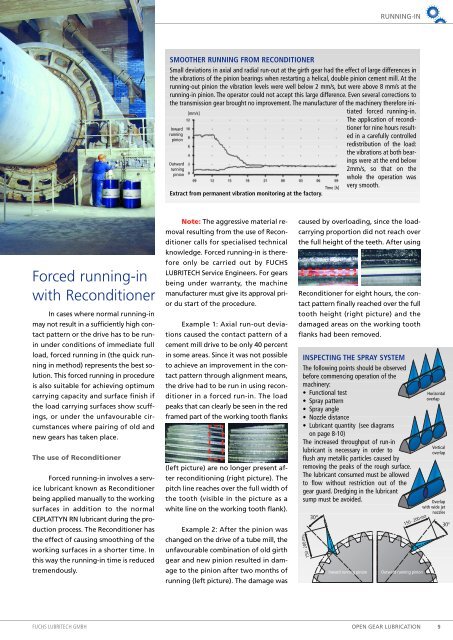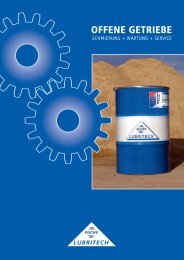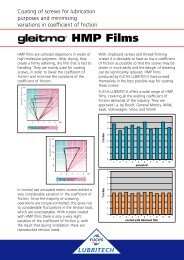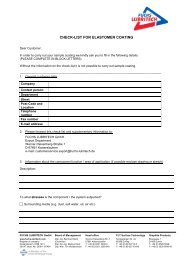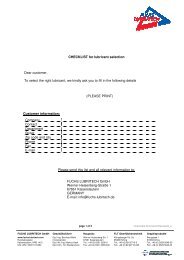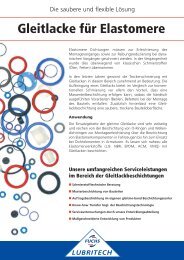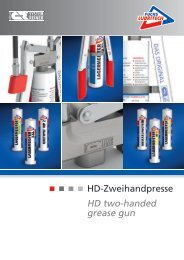english - FUCHS LUBRITECH GmbH
english - FUCHS LUBRITECH GmbH
english - FUCHS LUBRITECH GmbH
Create successful ePaper yourself
Turn your PDF publications into a flip-book with our unique Google optimized e-Paper software.
Forced running-in<br />
with Reconditioner<br />
In cases where normal running-in<br />
may not result in a sufficiently high contact<br />
pattern or the drive has to be runin<br />
under conditions of immediate full<br />
load, forced running in (the quick running<br />
in method) represents the best solution.<br />
This forced running in procedure<br />
is also suitable for achieving optimum<br />
carrying capacity and surface finish if<br />
the load carrying surfaces show scuffings,<br />
or under the unfavourable circumstances<br />
where pairing of old and<br />
new gears has taken place.<br />
The use of Reconditioner<br />
Forced running-in involves a service<br />
lubricant known as Reconditioner<br />
being applied manually to the working<br />
surfaces in addition to the normal<br />
CEPLATTYN RN lubricant during the production<br />
process. The Reconditioner has<br />
the effect of causing smoothing of the<br />
working surfaces in a shorter time. In<br />
this way the running-in time is reduced<br />
tremendously.<br />
<strong>FUCHS</strong> <strong>LUBRITECH</strong> GMBH<br />
SMOOTHER RUNNING FROM RECONDITIONER<br />
Note: The aggressive material removal<br />
resulting from the use of Reconditioner<br />
calls for specialised technical<br />
knowledge. Forced running-in is therefore<br />
only be carried out by <strong>FUCHS</strong><br />
<strong>LUBRITECH</strong> Service Engineers. For gears<br />
being under warranty, the machine<br />
manufacturer must give its approval prior<br />
du start of the procedure.<br />
Example 1: Axial run-out deviations<br />
caused the contact pattern of a<br />
cement mill drive to be only 40 percent<br />
in some areas. Since it was not possible<br />
to achieve an improvement in the contact<br />
pattern through alignment means,<br />
the drive had to be run in using reconditioner<br />
in a forced run-in. The load<br />
peaks that can clearly be seen in the red<br />
framed part of the working tooth flanks<br />
(left picture) are no longer present after<br />
reconditioning (right picture). The<br />
pitch line reaches over the full width of<br />
the tooth (visible in the picture as a<br />
white line on the working tooth flank).<br />
Example 2: After the pinion was<br />
changed on the drive of a tube mill, the<br />
unfavourable combination of old girth<br />
gear and new pinion resulted in damage<br />
to the pinion after two months of<br />
running (left picture). The damage was<br />
RUNNING-IN<br />
Small deviations in axial and radial run-out at the girth gear had the effect of large differences in<br />
the vibrations of the pinion bearings when restarting a helical, double pinion cement mill. At the<br />
running-out pinion the vibration levels were well below 2 mm/s, but were above 8 mm/s at the<br />
running-in pinion. The operator could not accept this large difference. Even several corrections to<br />
the transmission gear brought no improvement. The manufacturer of the machinery therefore ini-<br />
Inward<br />
running<br />
pinion<br />
Outward<br />
running<br />
pinion<br />
[mm/s]<br />
Time [h]<br />
Extract from permanent vibration monitoring at the factory.<br />
caused by overloading, since the loadcarrying<br />
proportion did not reach over<br />
the full height of the teeth. After using<br />
Reconditioner for eight hours, the contact<br />
pattern finally reached over the full<br />
tooth height (right picture) and the<br />
damaged areas on the working tooth<br />
flanks had been removed.<br />
150 - 200 mm<br />
INSPECTING THE SPRAY SYSTEM<br />
The following points should be observed<br />
before commencing operation of the<br />
machinery:<br />
Functional test<br />
Spray pattern<br />
Spray angle<br />
Nozzle distance<br />
Lubricant quantity (see diagrams<br />
on page 8-10)<br />
The increased throughput of run-in<br />
lubricant is necessary in order to<br />
flush any metallic particles caused by<br />
removing the peaks of the rough surface.<br />
The lubricant consumed must be allowed<br />
to flow without restriction out of the<br />
gear guard. Dredging in the lubricant<br />
sump must be avoided.<br />
30°<br />
tiated forced running-in.<br />
The application of reconditioner<br />
for nine hours resulted<br />
in a carefully controlled<br />
redistribution of the load:<br />
the vibrations at both bearings<br />
were at the end below<br />
2mm/s, so that on the<br />
whole the operation was<br />
very smooth.<br />
150 - 200 mm<br />
Inward running pinion Outward running pinion<br />
OPEN GEAR LUBRICATION<br />
Horizontal<br />
overlap<br />
Vertical<br />
overlap<br />
Overlap<br />
with wide jet<br />
nozzles<br />
9<br />
30°


